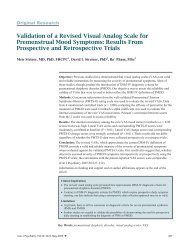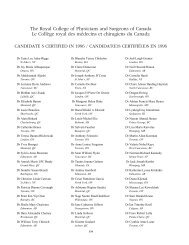Serum Lipid Concentrations in Obsessive–Compulsive Disorder ...
Serum Lipid Concentrations in Obsessive–Compulsive Disorder ...
Serum Lipid Concentrations in Obsessive–Compulsive Disorder ...
Create successful ePaper yourself
Turn your PDF publications into a flip-book with our unique Google optimized e-Paper software.
Brief Communication<br />
<strong>Serum</strong> <strong>Lipid</strong> <strong>Concentrations</strong> <strong>in</strong> <strong>Obsessive–Compulsive</strong><br />
<strong>Disorder</strong> Patients With and Without Panic Attacks<br />
Mehmet Yucel Agargun, MD 1 , Haluk Dulger, MD, PhD 2 , Rifat Inci, MD 3 , Hayrett<strong>in</strong> Kara, MD 1 ,<br />
Omer Akil Ozer, MD 4 , Mehmet Ramazan Sekeroglu, PhD 5 , Lutfullah Besiroglu, MD 4<br />
Key Words: obsessive–compulsive disorder, biological markers, neurochemistry<br />
Arelation between anxiety disorders and serum cholesterol<br />
level has been noted <strong>in</strong> contemporary psychiatric<br />
veterans with chronic PTSD (4). Consequently, it has been<br />
hypothesized that <strong>in</strong>creased catecholam<strong>in</strong>e level or <strong>in</strong>creased<br />
literature s<strong>in</strong>ce 1989 (1). Panic disorder patients have signifi- noradrenal<strong>in</strong> activity is related to lipoprote<strong>in</strong> lipase activity <strong>in</strong><br />
cantly higher serum cholesterol levels, compared with ageand<br />
sex-matched normal control subjects (2,3). It can be<br />
speculated that lipoprote<strong>in</strong> lipase is <strong>in</strong>duced by <strong>in</strong>creased<br />
noradrenal<strong>in</strong> activity <strong>in</strong> panic disorder (2). This leads to a suggestion<br />
that the elevated cholesterol level is associated with<br />
<strong>in</strong>creased autonomic arousal <strong>in</strong> panic disorder patients.<br />
PTSD patients as well as <strong>in</strong> panic disorder patients. Recent<br />
studies also report an association between <strong>in</strong>creased cholesterol<br />
level and generalized anxiety disorder and phobias<br />
(5–7).<br />
There are 3 studies of serum cholesterol level <strong>in</strong> patients with<br />
obsessive–compulsive disorder (OCD). Freedman and others<br />
found normal cholesterol levels <strong>in</strong> OCD (8), whereas Peter<br />
An elevated serum cholesterol level was also found <strong>in</strong> and others (9) and Peter and others (10) reported <strong>in</strong>creased<br />
posttraumatic stress disorder (PTSD) patients. Recently, cholesterol values <strong>in</strong> OCD patients, compared with control<br />
Kagan and others reported elevated lipid levels <strong>in</strong> Vietnam subjects. In our op<strong>in</strong>ion, this issue needs further <strong>in</strong>vestigation.<br />
776<br />
Objective: To exam<strong>in</strong>e serum lipid levels <strong>in</strong> patients with obsessive–compulsive disorder<br />
(OCD) and to test whether panic symptoms affect lipid concentrations <strong>in</strong> OCD patients.<br />
Methods: We assessed 33 OCD patients and 33 healthy control subjects matched for sex<br />
and age.<br />
Results: OCD patients had higher low-density lipoprote<strong>in</strong>, very-low-density lipoprote<strong>in</strong>,<br />
and tryglyceride levels, but lower high-density lipoprote<strong>in</strong> levels, than normal control<br />
subjects. We also found that only OCD patients with panic attacks had higher serum lipid<br />
concentrations, compared with normal control subjects. <strong>Serum</strong> lipid levels of pure OCD<br />
patients did not differ from control values.<br />
Conclusion: These f<strong>in</strong>d<strong>in</strong>gs suggest that high serum lipid concentrations are related to<br />
panic anxiety rather than other symptoms of the illness.<br />
(Can J Psychiatry 2004;49:776–778)<br />
Information on author affiliations appears at the end of the article.<br />
Cl<strong>in</strong>ical Implications<br />
� Obsessive–compulsive disorder (OCD) patients have higher serum lipid concentrations than<br />
do healthy control subjects.<br />
� Panic attacks may predict alterations <strong>in</strong> serum lipid concentration <strong>in</strong> OCD patients.<br />
� These f<strong>in</strong>d<strong>in</strong>gs may suggest that OCD patients are at risk for coronory artery disease.<br />
Limitations<br />
� The f<strong>in</strong>d<strong>in</strong>gs were from a relatively small group of patients.<br />
� Depressive symptoms and aggressiveness were not assessed <strong>in</strong> the patients.<br />
� We did not use an obssessive–compulsive scale to exam<strong>in</strong>e the relation between illness<br />
severity and serum lipid levels.<br />
� Can J Psychiatry, Vol 49, No 11, November 2004
<strong>Serum</strong> <strong>Lipid</strong> <strong>Concentrations</strong> <strong>in</strong> <strong>Obsessive–Compulsive</strong> <strong>Disorder</strong> Patients With and Without Panic Attacks<br />
Table 1 <strong>Serum</strong> lipid levels across the groups<br />
<strong>Serum</strong> lipids (mg daily)<br />
OCD and<br />
panic attack<br />
(n = 20)<br />
High-density lipoprote<strong>in</strong>, mean (SD) 37.1 (7.4) b<br />
Panic attacks are also relatively frequent <strong>in</strong> OCD patients.<br />
Thus there is a need to clarify whether a high serum cholesterol<br />
level is associated with panic anxiety or whether serum<br />
lipid concentrations are consistently high regardless of the<br />
occurrence of panic attacks. In this study, we tested whether<br />
panic symptoms affect serum lipid concentrations <strong>in</strong> OCD<br />
patients.<br />
Methods<br />
We <strong>in</strong>cluded 33 OCD patients and 33 healthy subjects <strong>in</strong> this<br />
study. OCD patients were recruited from consecutively<br />
present<strong>in</strong>g outpatients who sought psychiatric care at the Psychiatric<br />
Outpatient Cl<strong>in</strong>ic of the Yuzuncu Yil University Hospital<br />
<strong>in</strong> Van, Turkey. The patient and control groups were<br />
matched for sex and age. For each group, there were 18 men<br />
and 15 women. In each group, the subjects ranged <strong>in</strong> age from<br />
18 to 57 years (mean 29.3, SD 9.5 years).<br />
The OCD patient group was divided <strong>in</strong>to 2 subgroups: OCD<br />
patients with and without panic attacks. We used the Structured<br />
Cl<strong>in</strong>ical Interview for DSM-IV Axis I <strong>Disorder</strong>s–<br />
Cl<strong>in</strong>icianVersion (SCID-CV) (11) to establish OCD diagnosis<br />
and the presence of panic attacks without panic disorder.<br />
OCD patients with panic attacks were eligible for <strong>in</strong>clusion<br />
when their panic attacks were associated with obsessions and<br />
(or) compulsions. In other words, these subjects did not meet<br />
DSM-IV Criterion D for panic disorder.<br />
All participants had good physical health, as determ<strong>in</strong>ed by<br />
physical and laboratory exam<strong>in</strong>ation, and no history of psychotic<br />
disorders or current substance abuse. No OCD patients<br />
were treated with antidepressants or benzodiazep<strong>in</strong>es dur<strong>in</strong>g<br />
the study. We allowed a washout period of at least 2 weeks for<br />
psychotropic drugs before blood was collected. The control<br />
subjects were also drug-free dur<strong>in</strong>g the study.<br />
We obta<strong>in</strong>ed the subjects’ written <strong>in</strong>formed consent to participate<br />
<strong>in</strong> this study after the procedure(s) had been fully<br />
expla<strong>in</strong>ed. All were requested to avoid medication affect<strong>in</strong>g<br />
lipid levels (for example beta blockers, diuretics, androgens,<br />
estrogens, disulfiram, corticosteroids, levodopa, and am<strong>in</strong>osalycylic<br />
acid) for at least 2 weeks. All subjects absta<strong>in</strong>ed<br />
from a cholesterol-lower<strong>in</strong>g diet. Blood samples were drawn<br />
after a night of fast<strong>in</strong>g. Venipuncture was done <strong>in</strong> a sitt<strong>in</strong>g<br />
position with a tourniquet. Blood was then centrifuged at<br />
Pure OCD<br />
(n = 13)<br />
Healthy<br />
control subjects<br />
(n = 33)<br />
42.6 (10.3) 48.2 (12.3) 4.6 0.014<br />
Low-density lipoprote<strong>in</strong>, mean (SD) 89.3 (25.3) 83.5 (14.2) 98.4 (25.9) 1.47 0.28<br />
Very-low-density lipoprote<strong>in</strong>, mean (SD) 35.1 (22.2) b<br />
24.5 (16.1) 22.4 (7.7) 3.67 0.032<br />
Total cholesterol, mean (SD) 173.6 (39.8) 155.9 (29.2) 168.6 (20.7) 1.47 0.23<br />
Triglyseride, mean (SD) 158.1 (93.5) b<br />
129.4 (79.4) 111.8 (38.8) 2.98 0.05<br />
A analysis of variance<br />
b post hoc Bonferroni test; OCD and panic attack vs normal control subjects; P < 0.05<br />
OCD = obsessive–compulsive disorder<br />
1000 g for 1 m<strong>in</strong>ute <strong>in</strong> a refrigerated centrifuge, and the serum<br />
samples were separated from the cells. We determ<strong>in</strong>ed total<br />
cholesterol, triglyceride, and high-density lipoprote<strong>in</strong> (HDL)<br />
levels <strong>in</strong> the serum, us<strong>in</strong>g commercially available kits (Roche<br />
Diagnostic GmbH, Mannheim, Germany) on a Hitachi 747<br />
autoanalyzer (Hitachi Ltd, Tokyo, Japan). An enzymatic<br />
colorimetric method was used to determ<strong>in</strong>e total cholesterol<br />
and triglyceride. We used the direct HDL cholesterol method<br />
to measure HDL. Low-density lipoprote<strong>in</strong> (LDL) was calculated<br />
accord<strong>in</strong>g to the Friedewald formula (12).<br />
We used the statistical Package for the Social Sciences (SPSS)<br />
for W<strong>in</strong>dows version 9.01 (13) to perform analyses. Group<br />
data were analyzed us<strong>in</strong>g Student’s t test and one-way<br />
analysis of variance (ANOVA). We used the post hoc<br />
Bonferroni test to carry out post hoc comparisons of patient<br />
and normal subject means.<br />
Results<br />
There was a significant difference between OCD patients and<br />
normal control subjects <strong>in</strong> serum HDL, very-low-density<br />
lipoprote<strong>in</strong> (VLDL), and tryglyceride levels. HDL level was<br />
lower <strong>in</strong> OCD patients than <strong>in</strong> normal control subjects (mean<br />
39.3, SD 8.8 vs mean 48.2, SD 12.2; t = 2.84, P = 0.006).<br />
Conversely, VLDL and tryglyceride levels were higher (mean<br />
29.4, SD 19.7 vs mean 26.2, SD 7.1; t = 2.04, P = 0.047 and<br />
mean 154.6, SD 87.1 vs mean 130.1 SD 36.2; t = 2.38, P =<br />
0.043, respectively). Total cholesterol level did not differ<br />
between the groups (mean 164.4 SD 37.6 vs mean 173.6 SD<br />
15.5; t = 1.02, P = 0.31).<br />
As a second step, we classified OCD patients <strong>in</strong>to 2 subgroups:<br />
those who had panic attacks (at least 4 monthly) and<br />
those who never had panic attacks dur<strong>in</strong>g their illness. Table 1<br />
shows serum tryglyceride, total cholesterol, HDL, LDL, and<br />
VLDL levels across the groups. When we compared OCD<br />
patients with and without panic attacks and normal control<br />
subjects, we found a significant difference across the groups<br />
<strong>in</strong> HDL, VLDL, and tryglyceride levels. Post hoc comparison<br />
with the Bonferroni test revealed that significant differences<br />
<strong>in</strong> HDL, VLDL, and tryglyceride levels exist only between<br />
OCD patients with panic attacks and normal control subjects.<br />
Interest<strong>in</strong>gly, OCD patients without panic attacks did not differ<br />
from normal control subjects.<br />
Can J Psychiatry, Vol 49, No 11, November 2004 � 777<br />
F a<br />
P
The Canadian Journal of Psychiatry—Brief Communication<br />
Discussion<br />
In this study, we found that OCD patients had higher LDL,<br />
VLDL, and tryglyceride levels, but lower HDL levels, than<br />
normal control subjects. These f<strong>in</strong>d<strong>in</strong>gs replicate Peter and<br />
others’ (9) and Peter and others’ (10) reports. It may be suggested<br />
that OCD patients are at risk for coronory artery<br />
disease.<br />
In our second analysis, we found that only OCD patients with<br />
panic attacks had higher serum lipid concentrations when<br />
compared with normal control subjects. <strong>Serum</strong> lipid levels of<br />
pure OCD patients did not differ from control values. There<br />
has been much <strong>in</strong>terest <strong>in</strong> the cl<strong>in</strong>ical and biological overlap of<br />
panic disorder and OCD (14). The present study suggests that<br />
the presence of panic symptoms is associated with high lipid<br />
levels <strong>in</strong> OCD patients. In a recent study, we suggested that a<br />
low serum cholesterol level might serve as a biological marker<br />
of major depression <strong>in</strong> patients with panic disorder (15). Similarly,<br />
panic attacks may predict alterations <strong>in</strong> serum lipid concentration<br />
<strong>in</strong> OCD patients. A limitation of the present study is<br />
that we did not assess depressive symptoms and aggressiveness<br />
<strong>in</strong> our patients. Future research should focus on the effect<br />
of depressive comorbidity and aggressive behaviours on<br />
serum lipid alterations <strong>in</strong> OCD patients.<br />
References<br />
1. Agargun MY. <strong>Serum</strong> cholesterol concentration, depression, and anxiety<br />
[editorial]. Acta Psychiatr Scand 2002;105:81–3.<br />
2. Hayward C, Taylor CB, Roth WT, K<strong>in</strong>g R, Agras WS. Plasma lipid levels <strong>in</strong><br />
patients with panic disorder or agoraphobia. Am J Psychiatry 1989;146:917–9.<br />
3. Bajwa WK, Asnis GM, Irfan A, Von Praag HM. High cholesterol levels <strong>in</strong><br />
patients with panic disorder. Am J Psychiatry 1992;149:376 –8.<br />
4. Kagan BL, Lesk<strong>in</strong> G, Haas B, Wilk<strong>in</strong>s J, Foy D. Elevated lipid levels <strong>in</strong> Vietnam<br />
veterans with chronic posttraumatic stress disorder. Biol Psychiatry<br />
1999;45:374 –9.<br />
5. Kuczmierczyk AR, Barbee JG, Bologna NA, Townsend MH. <strong>Serum</strong> cholesterol<br />
levels <strong>in</strong> patients with generalized anxiety disorder (GAD) and with GAD and<br />
comorbid major depression. Can J Psychiatry 1996;41:465– 8.<br />
778<br />
6. Peter H, Goebel PN, Müller S, Hand I. Cl<strong>in</strong>ically relevant cholesterol elevation<br />
<strong>in</strong> anxiety disorders: a comparison with normal controls. Int J Behav Med<br />
1999;6:30 –9.<br />
7. Sev<strong>in</strong>cok L, Buyukozturk A, Dereboy F. <strong>Serum</strong> lipid concentrations <strong>in</strong> patients<br />
with comorbid generalized anxiety disorder and major depressive disorder. Can J<br />
Psychiatry 2001;46:68–71.<br />
8. Freedman DS, Byers T, Barrett DH, Stroup NE, Eaker E, Monroe-Blum H.<br />
Plasma lipid levels and psychological characteristics <strong>in</strong> men. Am J Epidemiol<br />
1995;141:507–17.<br />
9. Peter H, Hand I, Hohagen F, Koenig A, M<strong>in</strong>dermann O, Oeder F, and others.<br />
<strong>Serum</strong> cholesterol level comparison: control subjects, anxiety disorder patients,<br />
and obsessive–compulsive disorder patients. Can J Psychiatry 2002;47:557– 61.<br />
10. Peter H, Tabrizian S, Hand I. <strong>Serum</strong> cholesterol <strong>in</strong> patients with<br />
obsessive–compulsive disorder dur<strong>in</strong>g treatment with behaviour therapy and<br />
SSRI versus placebo. Int J Psychiatry Med 2000;30:27–39.<br />
11. First MB, Spitzer RL, Gibbon M, Williams JBW. Structured Cl<strong>in</strong>ical Interview<br />
for DSM-IVAxis I <strong>Disorder</strong>s-Cl<strong>in</strong>ician Version (SCID-CV).Wash<strong>in</strong>gton (DC):<br />
American Psychiatric Press; 1997.<br />
12. Friedewald WT, Levy RI, Fredricskon DS. Estimation of the concentration of the<br />
low-density lipoprote<strong>in</strong> cholesterol <strong>in</strong> plasma, without use of the preparative<br />
ultracentrifuge. Cl<strong>in</strong> Chem 1972;18:499–502.<br />
13. SPSS Inc. SPSS for W<strong>in</strong>dows. Version 9.01. Chicago (IL): SPSS Inc; 1999.<br />
14. Agargun MY, Kara H, Alpkan L, Ucisik M. Obsessive-compulsive symptoms <strong>in</strong><br />
panic disorder. Eur Psychiatry 1996;11:207–8.<br />
15. Agargun MY, Algün E, �ekero�lu R, Kara H, Tarakçio�lu M. Low cholesterol<br />
level <strong>in</strong> patients with panic disorder: the association with major depression. J<br />
Affect Disord 1998;50:29-32.<br />
Manuscript received September 2003, revised, and accepted January 2004.<br />
1 Professor of Psychiatry, Yuzuncu Yil University School of Medic<strong>in</strong>e<br />
Department of Psychiatry, Van, Turkey.<br />
2 Assistant Professor of Biochemistry, Yuzuncu Yil University School of<br />
Medic<strong>in</strong>e Department of Biochemistry, Van, Turkey.<br />
3 Psychiatry Resident, Yuzuncu Yil University School of Medic<strong>in</strong>e<br />
Department of Psychiatry, Van, Turkey.<br />
4 Assistant Professor of Psychiatry, Yuzuncu Yil University School of<br />
Medic<strong>in</strong>e Department of Psychiatry, Van, Turkey.<br />
5 Professor of Biochemistry, Yuzuncu Yil University School of Medic<strong>in</strong>e<br />
Department of Biochemistry, Van, Turkey.<br />
Address for correspondence: Dr MY Agargun, Yuzuncu Yil University,<br />
School of Medic<strong>in</strong>e, Department of Psychiatry and Neuroscience Research<br />
Center Van 65200, Turkey<br />
e-mail: myagargun@kure.com.tr<br />
Résumé : <strong>Concentrations</strong> de lipide sérique chez les patients souffrant du trouble<br />
obsessionnel-compulsif avec et sans crises de panique<br />
Objectif : Exam<strong>in</strong>er les niveaux de lipide sérique chez les patients souffrant du trouble<br />
obsessionnel-compulsif (TOC) et vérifier si les symptômes de panique <strong>in</strong>fluent sur les concentrations<br />
de lipide sérique chez les patients souffrant du TOC.<br />
Méthodes : Nous avons évalué 33 patients souffrant du TOC et 33 sujets témo<strong>in</strong>s en santé assortis<br />
selon l’âge et le sexe.<br />
Résultats : Les patients souffrant du TOC avaient des niveaux plus élevés de lipoproté<strong>in</strong>es de basse<br />
densité, de lipoproté<strong>in</strong>es de très faible densité et de triglycérides, mais des niveaux plus faibles de<br />
lipoproté<strong>in</strong>es de haute densité que les sujets témo<strong>in</strong>s normaux. Nous avons également constaté que<br />
seuls les patients souffrant du TOC avec crises de panique avaient des concentrations de lipide sérique<br />
plus élevées, comparativement aux sujets témo<strong>in</strong>s normaux. Les niveaux de lipide sérique des patients<br />
souffrant seulement du TOC ne différaient pas des valeurs témo<strong>in</strong>s.<br />
Conclusion : Ces résultats <strong>in</strong>diquent que les concentrations élevées de liquide sérique sont reliées à<br />
l’anxiété panique plutôt qu’à d’autres symptômes de la maladie.<br />
� Can J Psychiatry, Vol 49, No 11, November 2004







